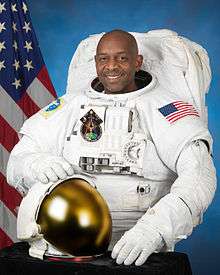Robert Satcher
Robert Lee "Bobby" Satcher Jr. (born September 22, 1965) is an American physician, chemical engineer, and NASA astronaut.[4] He became the first orthopedic surgeon in space during STS-129.[5] He participated in 2 spacewalks during STS-129, accumulating 12hrs 19min of EVA time. Satcher holds two doctorates (Ph.D., M.D.) and has received numerous awards and honors as a surgeon and engineer.
Robert Lee Satcher Jr. | |
|---|---|
 | |
| Born | September 22, 1965 Hampton, Virginia, United States |
| Status | Retired[1] |
| Nationality | American |
| Occupation | Physician |
| Space career | |
| NASA Astronaut | |
Time in space | 10d 19h 16m[2] |
| Selection | 2004 NASA Group 19 |
Total EVAs | 2 |
Total EVA time | 12 hours, 19 minutes[3] |
| Missions | STS-129 |
Mission insignia | |
Background
Born in Hampton, Virginia, Satcher graduated from Denmark-Olar High School in Denmark, South Carolina (1982), and went on to receive a Bachelor of Science degree as well as a doctorate in Chemical Engineering from the Massachusetts Institute of Technology. He then went on to study medicine at Harvard Medical School, and received his medical doctorate in 1994. Satcher did his internship and residency at the University of California, San Francisco from 1995–2000, and postdoctoral research fellowship at University of California, Berkeley in 1998, and an orthopedic oncology fellowship at the University of Florida from 2000–2001.[4]
Prior to being accepted into the astronaut program by NASA, Satcher was the Assistant Professor at The Feinberg School of Medicine, Northwestern University, in the Department of Orthopaedic Surgery. Satcher also held appointments as an Attending Physician in Orthopaedic Surgery at Children's Memorial Hospital in Chicago, Illinois, specializing in Musculoskeletal Oncology; and an Adjunct Appointment in The Biomedical Engineering Department at Northwestern University School of Engineering.[4]
Satcher was also a member of the Robert H. Lurie Comprehensive Cancer Center and the Institute for Bioengineering and Nanotechnology in Advanced Medicine at Northwestern University. Satcher was also a Schweitzer Fellow at the Albert Schweitzer Hospital, in Lambaréné, Gabon. Satcher's experience in engineering includes internships at DuPont in the Textile Fibers Research Group, and the Polymer Products Division.[4]
NASA career
Selected by NASA in May 2004, Satcher completed Astronaut Candidate Training in February 2006. Satcher later worked on the STS-129 mission as a Mission Specialist.[6] Satcher spent over 259 hours in space and participated in two of the three spacewalks, totaling 12hr 19min.
 Satcher and Leland Melvin floating inside Node 2. Jeff Williams is enjoying a water drink.
Satcher and Leland Melvin floating inside Node 2. Jeff Williams is enjoying a water drink. Satcher in the Space Shuttle during STS-129
Satcher in the Space Shuttle during STS-129 Satcher during his EVA
Satcher during his EVA
University of Texas M.D. Anderson Cancer Center
Satcher joined The University of Texas M.D. Anderson Cancer Center in 2011, in the Department of Orthopaedic Oncology.
Personal life
He is married and has two children. Bobby Satcher enjoys running, scuba diving, and reading.
Awards and honors
Satcher was a National Merit Scholar, and received the Monsanto Award and the Albert G. Hill Award from MIT, fellowships from both the Robert Wood Johnson Foundation and UNCF/Merck Research department, and is a member of the Tau Beta Pi Engineering Honor Society.[4]
See also
References
![]()
- "Astronaut Bio: Robert Satcher Jr". NASA. NASA-JSC Media Releases. Retrieved November 10, 2015.
- Astronauts and Cosmonauts (sorted by "Time in Space"). spacefacts.de
- STS-129
- National Aeronautics and Space Administration (2008). "Robert L. Satcher Jr. (Ph.D., M.D.)". NASA. Retrieved September 2, 2008.
- Northwestern University (2009). "Northwestern Doctor Will Be First Orthopedic Surgeon in Space". Northwestern University. Retrieved December 25, 2009.
- NASA (2008). "NASA Assigns Crew For Space Shuttle Discovery's Sts-129 Mission". NASA. Retrieved February 22, 2010.